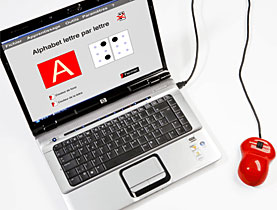Blind mouse improves Braille learning

Exactly 200 years after the birth of Louis Braille, the system he invented to enable blind people to read and write has entered the electronic age.
This time it is a Swiss researcher who is applying a bit of technical wizardry and a lot of practicality to help people get the hang of Braille’s binary code more quickly.
Philippe Racine, the maker of the Mouskie, a mouse-software system, says that when launched, it will be a product with no competitors in a market of 200 million people around the world.
The birth of Mouskie is primarily a story of friendship between Racine, from the Valais School of Engineering in southwest Switzerland, and Jean-Marc Meyrat, the president of the French-speaking branch of Switzerland’s association for the blind.
“With Jean-Marc we are looking at new possibilities for the blind, to use a coffee machine or do the cooking, in terms of accessibility or usage,” says Racine. “And I am also a consultant for aesthetics. This is important. Just because something is a tool for the blind does not mean it should be ugly.”
The discussions of Racine and Meyrat would often touch upon the Braille system. Meyrat notes that it is becoming increasingly difficult to motivate people to learn the system when they have other options, like listening to a computer read out text.
“In the early days of computing for the blind, it was thought [computers] would replace Braille,” Racine said. “But synthesised speech does not allow for the learning of reading and writing. If we want to do this, the only solution is Braille.”
“Computer reflexes”
Over the past two centuries, the Braille system, which uses an alphabet comprising different combinations of six dots, has hardly changed and the traditional method, in which a teacher places wooden pegs under the fingers of the student, still stands.
“For the young Nintendo generation, which almost has ‘computer reflexes’ in its blood, this should reinvigorate everything,” said Racine.
Mouskie caters to the blind, people who are losing their sight as well as those without visual impairments.
It works like this: the user types a letter on a standard computer keyboard. The letter appears very large on the screen, the software reads it out and its Braille code is sent to the device, which raises the corresponding pins to match the letter and make contact with the user’s finger.
Quick and easy
“Apart from the playful side, there is a great speed advantage with this system,” explains Racine. “And it has been established that memorisation based on touch is very dependant on the speed of execution.”
The result is that using Mouskie to learn Braille is five to six times faster.
“People often mistakenly believe that learning Braille is learning a new language, although it is only another alphabet,” said Racine, who says he learned it “quite easily”.
Mouskie also helps people facing total blindness to cope psychologically. An early mastery of Braille allows them to better deal with the process of losing their sight and allows them to become independent more quickly.
Potential for global success
Mouskie is the product of three years of development and has been supported by NetAtelier, a Valais-based firm, and by designer Jean-Maurice Varone, who was inspired by pebbles on the Rhone when designing the device.
The Valais School of Engineering has developed the electronics, but Racine himself has invested nearly SFr300,000 ($271,000) out of his own pocket.
He has marketed the device at fairs in Frankfurt, Warsaw, London and Geneva, which in 2008 hosted the meeting of the World Blind Union. There was great interest, he says, adding that the Mouskie should have a strong future.
Mass production will be split between Milan, where the mouse’s shell is produced, and Stuttgart, which will take care of the electronics and assembly. Distribution will come thanks to associations for the blind in Switzerland, Germany, the United States and Britain.
swissinfo, based on an article in French by Marc-André Miserez
Louis Braille was born on January 4, 1809 in Coupvray, near Paris. He injured his left eye with a sharp tool in the workshop of his father, who manufactured saddles and harnesses. Three years after the accident, the wound became infected and he lost his sight.
At the age of ten, he won a scholarship to join the Royal Institution for Blind Youth in Paris. The children learned to read raised letters but had no system for writing.
Three years later, he invented the system of raised dots, inspired by Charles Barbier de la Serra, an army captain who developed the method to allow his soldiers to exchange orders at night.
The Barbier code was phonetic, complicated and based on twelve dots. Braille’s six-dot system allows for the transcription of letters, numbers and other symbols.
Braille died of tuberculosis at the age of 43. His body rests in Paris’s famed Panthéon.
A person who cannot read a newspaper with glasses or contact lenses, or whose vision hampers day-to-day life is considered visually impaired.
There is a lack of statistics about how many people are affected in Switzerland although Switzerland’s association for the blind estimates that between 80,000 and 100,000 people have a visual impairment.
There are many associations and private foundations to assist the visually impaired, funded by donations, disability insurance and self-generated income.
Services in Switzerland include rehabilitation centres, schools, workshops, social associations, libraries and schools for guide dogs.

In compliance with the JTI standards
More: SWI swissinfo.ch certified by the Journalism Trust Initiative













You can find an overview of ongoing debates with our journalists here . Please join us!
If you want to start a conversation about a topic raised in this article or want to report factual errors, email us at english@swissinfo.ch.